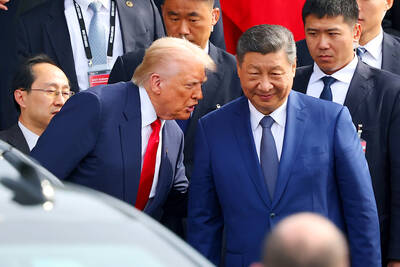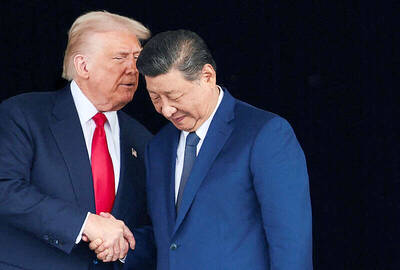The twists and turns of a turbulent week on Wall Street have made traders dizzy, but analysts are looking for a calmer ride in the coming week as the market digests the latest efforts to battle the financial market firestorm.
The mood has shifted from panic to euphoria as the financial system froze up. But some say the crisis in markets shows signs of easing.
The major US indexes ended little changed despite the unprecedented volatility.
The blue-chip Dow Jones Industrial Average fell 0.29 percent on the week to 11,388.44 after big rallies on Thursday and Friday recouped heavy losses earlier in the week.
The broad-market Standard & Poor’s 500 index rose 0.27 percent to 1,255.08 and the technology-heavy NASDAQ composite managed a gain of 0.56 percent to 2,273.90.
“I’m not sure I’ve ever seen such volatility,” said Andy Brooks, head of trading at T. Rowe Price, after one hectic back-and-forth session.
The historic week came as Wall Street giant Lehman Brothers collapsed after failing to find a buyer and the US government offered an US$85 billion lifeline to insurance giant American International Group Inc to stave off a financial market tsunami.
Meanwhile Merrill Lynch made an emergency deal to sell itself to Bank of America.
The government action failed to calm financial markets and at midweek credit markets appeared to seize up, forcing central banks to offer massive amounts of liquidity to the banking system. At one point, investors flocked to gold, oil and short-term Treasury bills in a massive flight to safety.
Amid the firestorm, the US government announced a plan described as “the mother of all bailouts” in an effort to help banks and financial firms purge their books of the so-called toxic mortgage assets stemming from the housing market collapse. The plan appeared to help skittish markets settle down.
“Wall Street appears to have turned the corner,” said Fred Dickson at DA Davidson & Co, reacting to what he called “a package designed to attack the problems at the heart of the financial crisis and reduce the general level of fear that has move moved onto Main Street.”
“While we doubt the comprehensive plan, in whatever form it finally emerges from Congress, immediately ends the housing crisis or will get the economy back on a more traditional growth track, it should provide stability to the stock market and restore confidence to the global banking system,” he said.
Bond prices were lower after sharp swings over the week.
The yield on the 10-year Treasury bond rose to 3.769 percent from to 3.730 percent a week earlier, and that on the 30-year bond increased to 4.366 percent from 4.326. Bond yields and prices move in opposite directions.

CALL FOR SUPPORT: President William Lai called on lawmakers across party lines to ensure the livelihood of Taiwanese and that national security is protected President William Lai (賴清德) yesterday called for bipartisan support for Taiwan’s investment in self-defense capabilities at the christening and launch of two coast guard vessels at CSBC Corp, Taiwan’s (台灣國際造船) shipyard in Kaohsiung. The Taipei (台北) is the fourth and final ship of the Chiayi-class offshore patrol vessels, and the Siraya (西拉雅) is the Coast Guard Administration’s (CGA) first-ever ocean patrol vessel, the government said. The Taipei is the fourth and final ship of the Chiayi-class offshore patrol vessels with a displacement of about 4,000 tonnes, Lai said. This ship class was ordered as a result of former president Tsai Ing-wen’s (蔡英文) 2018

UKRAINE, NVIDIA: The US leader said the subject of Russia’s war had come up ‘very strongly,’ while Jenson Huang was hoping that the conversation was good Chinese President Xi Jinping (習近平) and US President Donald Trump had differing takes following their meeting in Busan, South Korea, yesterday. Xi said that the two sides should complete follow-up work as soon as possible to deliver tangible results that would provide “peace of mind” to China, the US and the rest of the world, while Trump hailed the “great success” of the talks. The two discussed trade, including a deal to reduce tariffs slapped on China for its role in the fentanyl trade, as well as cooperation in ending the war in Ukraine, among other issues, but they did not mention

HOTEL HIRING: An official said that hoteliers could begin hiring migrant workers next year, but must adhere to a rule requiring a NT$2,000 salary hike for Taiwanese The government is to allow the hospitality industry to recruit mid-level migrant workers for housekeeping and three other lines of work after the Executive Yuan yesterday approved a proposal by the Ministry of Labor. A shortage of workers at hotels and accommodation facilities was discussed at a meeting of the legislature’s Transportation Committee. A 2023 survey conducted by the Tourism Administration found that Taiwan’s lodging industry was short of about 6,600 housekeeping and cleaning workers, the agency said in a report to the committee. The shortage of workers in the industry is being studied, the report said. Hotel and Lodging Division Deputy Director Cheng

‘SECRETS’: While saying China would not attack during his presidency, Donald Trump declined to say how Washington would respond if Beijing were to take military action US President Donald Trump said that China would not take military action against Taiwan while he is president, as the Chinese leaders “know the consequences.” Trump made the statement during an interview on CBS’ 60 Minutes program that aired on Sunday, a few days after his meeting with Chinese President Xi Jinping (習近平) in South Korea. “He [Xi] has openly said, and his people have openly said at meetings, ‘we would never do anything while President Trump is president,’ because they know the consequences,” Trump said in the interview. However, he repeatedly declined to say exactly how Washington would respond in